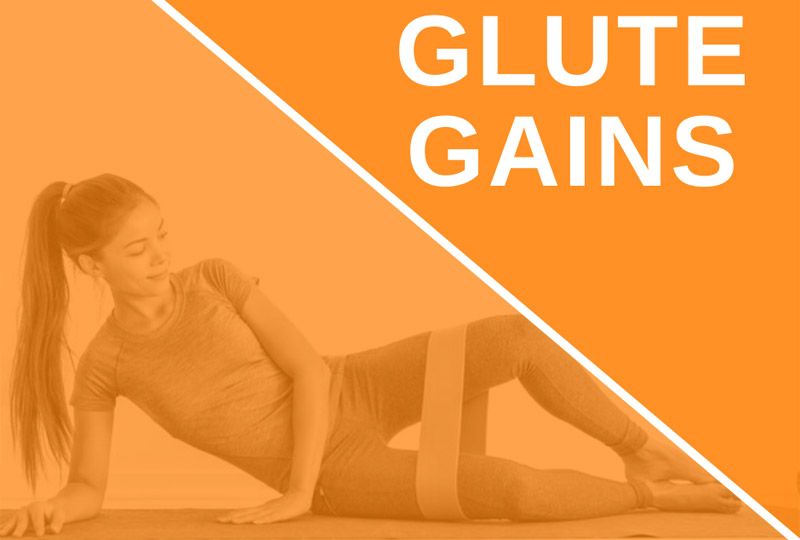There has been a fair amount of focus on glute gains and growth in the personal training and fitness industry as of late. In particular, it seems the hip thrust has become the number one go-to glute-growth exercise. As discussed last month, this horizontal push movement helps achieve strong glutes, improves horizontal push force, and creates the coveted aesthetically plump look.
Accessory Work
While the big lifts and compound movements tend to have the most overall effect on body composition, accessory exercises are the smaller, less intense exercises that help improve imbalances and improve technique and strength.
The Glute Stars and Their Supporting Roles
If glute gain goals were a hit movie, hip thrusts, squats, and deadlifts would be the stars. But the supporting roles would be the accessory exercises that complement and improve these larger exercises.
There is certainly no shortage of glute accessory exercises to choose from, but we can’t add them all in for every workout session. Therefore, I propose adding the following five accessory movements for four to six weeks to help clients target their glutes.
Five Accessory Moves: Muscles Targeted and Techniques
1) Side lying hip abduction (AKA: Clamshells)
Target: The glute medius is the prime mover in this exercise.
Technique: First, add a mini-band either just above or below the knees. Then, lay on one side of the body with knees bent at a 45-degree angle, shoulders in line with the hips. Knees, hips, and shoulders are all stacked on top of one another. Bottom arm can hold the head or rest on the floor. Keep the feet together while lifting the top leg as high as possible without shifting the hips or pelvis. Lower knee back to starting position and repeat.
* Another variation to this movement is standing hip abduction.
2) Frog pumps
Target: All three major glute muscles, maximus, medius, and minimus are activated, as are the quads, hamstrings, spinal erectors, and adductors to varying degrees.
Technique: Lay supine either on the floor or with the back on a balance trainer. Bring the heels of the feet together and the knees out so the hips are externally rotated (like frog legs!). Press into the sides of the feet to push the hips up and lower back down. Torso stays long and head faces the ceiling.
3) Isometric single leg hip bridge
Target: All three major glute muscles, maximus, medius, and minimus are engaged in this movement.
Technique: Lie on the floor with feet lined up under bent knees. (Shifting feet forward so that the knees are bent to 90 degrees may engage glutes slightly more.) Drive through the heel to lift the hips in the air. Then, lift one leg in the air placing all of the balance in one leg. Hold that position for 20-30 seconds.
*add a balance trainer or elevated surface under the feet to create a dynamic exercise.
4) Romanian deadlift
Target: The primary targets in this exercise are the hamstrings and glutes, however, forearm flexors, core, traps, lats, and erectors also challenged.
Technique: Start with a straight spine and the feet hip-width apart while holding a barbell, dumbbells, or even a kettlebell in front of the body. Squeeze the shoulder blades back and keep them together from start to finish. Hinge the hips back bringing the torso parallel to the floor imagining a yardstick strapped to the back, where head and spine stay affixed.
Keep only a soft bend in the knees (differentiating the movement from a conventional deadlift), executing a slow eccentric phase, stopping at the shins, rather than returning the weight to the ground, and drive through the feet to return to standing tall and proud.
*To create variation in this movement, try single-leg RDL’s or snatch grip deadlifts.
5) Rear foot elevated split squat (AKA: Bulgarian Squat)
Target: All three major glute muscles, maximus, medius, and minimus in addition to the core for stability are fired up in this exercise.
Technique: Place the back foot on an elevated surface such as a box or bench, laces down. Step the front leg out far enough so that when the front knee bends, it lines up right over the foot. Drop the back knee down towards the floor and the front thigh to parallel.
*Options for added intensity: slow the eccentric phase down to a four-count, place the back foot in the cradle of a suspension trainer, and/or hold dumbbells at the sides.
Not only will these five exercises greatly contribute to stronger, shapelier glutes, but they will play a vital role in enhanced technique and form in some of the bigger lifts like squat, deadlifts, and hip thrusts.
Adding Accessory Exercises to the Program
It is not uncommon to see accessory exercises thrown in at the end of a workout that began with bigger lifts. Even though the big lifts take a lot out of the body, when there is a little gas left in the tank, it is really a great time to work on accessory movements. If big lifts are not on the menu for the day but there is some metcon or circuit training involved, don’t be afraid to program a few accessory movements throughout. They can serve as active recovery.
References:
https://barbend.com/romanian-deadlift/#muscles
https://barbend.com/exercises-gloriously-strong-glutes/
https://www.healthline.com/health/fitness-exercise/the-clamshell-exercise#who-its-for
Theresa Perales has an MA in Spanish, and is an ESL teacher at San Diego State University (SDSU). After years of struggling with her weight, she decided to give exercise a try. A passion for health and fitness grew instantly and inspired her to become certified as a personal trainer with NFPT, and as a group fitness instructor with AFAA Group Fitness and Madd Dog Athletics® Spinning. Theresa believes that nutrition and fitness are not about aesthetics but ultimately about feeling healthy and empowered.


